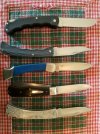I'm some late getting back. The results: my wife and I were in agreement on the top 2 knives, which were the sod buster and the thin blade Bucklite clip point. There was not doubt in either of our minds. Those 2 were the top cutters on the apple. The next pair we were in disagreement about. She picked it just as the photo shows; the #3 knife being SK's 110 drop point w/ s90v steel and 4 the 334 Camillus Trapper with full flat grind. My pick on this middle pair was these two switched. #3 being the 334 Trapper and #4 SK's drop point in s90v steel.
So, this middle pair is real close. The last blade had not been thinned and it had a broken point when I purchased it. Which I restored. Still, this
blade needs some thinning to be in the same class as the others. Even though it is mirror polished it had a thick profile and required more force to make the cuts but was still a good cutting steel.
Which leads me to a top point with this: steel type is not a major part of the way a blade cuts. (2 of the tops was 420 steel) Perhaps how long it cuts.
Point 2, one would have to purchase a custom ground blade to notice much difference in cutting enhancement and all of these are not made head and shoulders above. As there were only 'subtle' differences in how the top 4 cut. Feel free to disagree, I'll respect your opinion. I still have a pumpkin and can run the test again on this material. Thanks, DM

